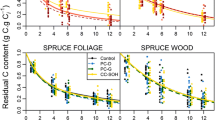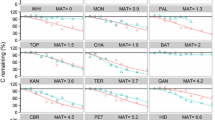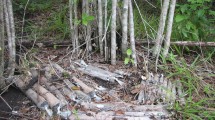Abstract
Decomposition rate constants were measured for boles of 155 large dead trees (>10 cm diameter) in central Amazon forests. Mortality data from 21 ha of permanent inventory plots, monitored for 10–15 years, were used to select dead trees for sampling. Measured rate constants varied by over 1.5 orders of magnitude (0.015–0.67 year–1), averaging 0.19 year–1 with predicted error of 0.026 year. Wood density and bole diameter were significantly and inversely correlated with rate constants. A tree of average biomass was predicted to decompose at 0.17 year–1. Based on mortality data, an average of 7.0 trees ha–1 year–1 died producing 3.6 Mg ha–1 year–1 of coarse litter (>10 cm diameter). Mean coarse litter standing-stocks were predicted to be 21 Mg ha–1, with a mean residence time of 5.9 years, and a maximum mean carbon flux to the atmosphere of 1.8 Mg C ha–1 year–1. Total litter is estimated to be partitioned into 16% fine wood, 30% coarse wood, and 54% non-woody litter (e.g., leaves, fruits, flowers). Decomposition rate constants for coarse litter were compiled from 20 globally distributed studies. Rates were highly correlated with mean annual temperature, giving a respiration quotient (Q 10) of 2.4 (10°C–1).
Similar content being viewed by others
Author information
Authors and Affiliations
Additional information
Received: 14 June 1999 / Accepted: 31 August 1999
Rights and permissions
About this article
Cite this article
Chambers, J., Higuchi, N., Schimel, J. et al. Decomposition and carbon cycling of dead trees in tropical forests of the central Amazon. Oecologia 122, 380–388 (2000). https://doi.org/10.1007/s004420050044
Issue Date:
DOI: https://doi.org/10.1007/s004420050044




